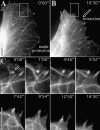Microtubule targeting of substrate contacts promotes their relaxation and dissociation
- PMID: 10477757
- PMCID: PMC2169483
- DOI: 10.1083/jcb.146.5.1033
Microtubule targeting of substrate contacts promotes their relaxation and dissociation
Abstract
We recently showed that substrate contact sites in living fibroblasts are specifically targeted by microtubules (Kaverina, I., K. Rottner, and J.V. Small. 1998. J. Cell Biol. 142:181-190). Evidence is now provided that microtubule contact targeting plays a role in the modulation of substrate contact dynamics. The results are derived from spreading and polarized goldfish fibroblasts in which microtubules and contact sites were simultaneously visualized using proteins conjugated with Cy-3, rhodamine, or green fluorescent protein. For cells allowed to spread in the presence of nocodazole the turnover of contacts was retarded, as compared with controls and adhesions that were retained under the cell body were dissociated after microtubule reassembly. In polarized cells, small focal complexes were found at the protruding cell front and larger adhesions, corresponding to focal adhesions, at the retracting flanks and rear. At retracting edges, multiple microtubule contact targeting preceded contact release and cell edge retraction. The same effect could be observed in spread cells, in which microtubules were allowed to reassemble after local disassembly by the application of nocodazole to one cell edge. At the protruding front of polarized cells, focal complexes were also targeted and as a result remained either unchanged in size or, more rarely, were disassembled. Conversely, when contact targeting at the cell front was prevented by freezing microtubule growth with 20 nM taxol and protrusion stimulated by the injection of constitutively active Rac, peripheral focal complexes became abnormally enlarged. We further found that the local application of inhibitors of myosin contractility to cell edges bearing focal adhesions induced the same contact dissociation and edge retraction as observed after microtubule targeting. Our data are consistent with a mechanism whereby microtubules deliver localized doses of relaxing signals to contact sites to retard or reverse their development. We propose that it is via this route that microtubules exert their well-established control on cell polarity.
Figures











Similar articles
-
Mechanisms of polarization of the shape of fibroblasts and epitheliocytes: Separation of the roles of microtubules and Rho-dependent actin-myosin contractility.Proc Natl Acad Sci U S A. 2002 Aug 6;99(16):10452-7. doi: 10.1073/pnas.152339899. Epub 2002 Jul 29. Proc Natl Acad Sci U S A. 2002. PMID: 12149446 Free PMC article.
-
Targeting, capture, and stabilization of microtubules at early focal adhesions.J Cell Biol. 1998 Jul 13;142(1):181-90. doi: 10.1083/jcb.142.1.181. J Cell Biol. 1998. PMID: 9660872 Free PMC article.
-
Microtubule-targeting-dependent reorganization of filopodia.J Cell Sci. 2007 Apr 1;120(Pt 7):1235-44. doi: 10.1242/jcs.003913. Epub 2007 Mar 13. J Cell Sci. 2007. PMID: 17356063
-
Microtubule involvement in regulating cell contractility and adhesion-dependent signalling: a possible mechanism for polarization of cell motility.Biochem Soc Symp. 1999;65:147-72. Biochem Soc Symp. 1999. PMID: 10320938 Review.
-
Microtubules in cell migration.Annu Rev Cell Dev Biol. 2013;29:471-99. doi: 10.1146/annurev-cellbio-101011-155711. Epub 2013 Jul 12. Annu Rev Cell Dev Biol. 2013. PMID: 23875648 Review.
Cited by
-
Dynamic microtubules produce an asymmetric E-cadherin-Bazooka complex to maintain segment boundaries.J Cell Biol. 2013 Jun 10;201(6):887-901. doi: 10.1083/jcb.201211159. J Cell Biol. 2013. PMID: 23751496 Free PMC article.
-
Post-polymerization crosstalk between the actin cytoskeleton and microtubule network.Bioarchitecture. 2016 May 3;6(3):53-9. doi: 10.1080/19490992.2016.1171428. Bioarchitecture. 2016. PMID: 27058810 Free PMC article.
-
Filopodial initiation and a novel filament-organizing center, the focal ring.Mol Biol Cell. 2001 Aug;12(8):2378-95. doi: 10.1091/mbc.12.8.2378. Mol Biol Cell. 2001. PMID: 11514623 Free PMC article.
-
Alpha-smooth muscle actin is crucial for focal adhesion maturation in myofibroblasts.Mol Biol Cell. 2003 Jun;14(6):2508-19. doi: 10.1091/mbc.e02-11-0729. Epub 2003 Feb 21. Mol Biol Cell. 2003. PMID: 12808047 Free PMC article.
-
2,3-butanedione monoxime (BDM), a potent inhibitor of actin-myosin interaction, induces ion and fluid transport in MDCK monolayers.J Muscle Res Cell Motil. 2002;23(3):223-34. doi: 10.1023/a:1020979203141. J Muscle Res Cell Motil. 2002. PMID: 12500902
References
-
- Bershadsky A.D., Vasiliev J.M. Cytoskeleton 1988. Plenum Press; New York: pp. 298 pp
-
- Bershadsky A., Chausovsky A., Becker E., Lyubimova A., Geiger B. Involvement of microtubules in the control of adhesion-dependent signal transduction. Curr. Biol. 1996;6:1279–1289. - PubMed
-
- Best A., Ahmed S., Kozma R., Lim L. The Ras-related GTPase Rac1 binds tubulin. J. Biol. Chem. 1996;271:3756–3762. - PubMed
-
- Chen W.-T. Surface changes during retraction-induced spreading of fibroblasts. J. Cell Sci. 1981;49:1–13. - PubMed
Publication types
MeSH terms
Substances
LinkOut - more resources
Full Text Sources
Other Literature Sources
Miscellaneous

